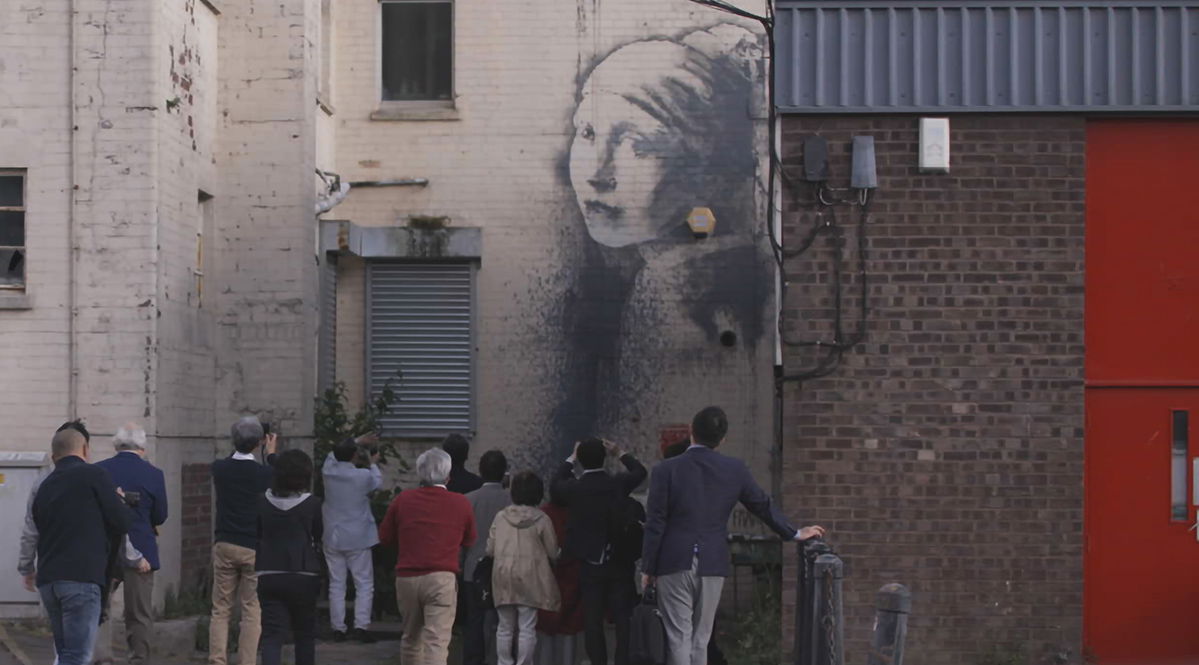In a world where fame is worth just as much social currency as the achievements that are supposed to engender it, a person like Banksy can become a cultural flashpoint. The artist, who remains anonymous despite countless hunts to unmask them, has transcended artistic forms, traditional avenues of expression, and even modern constructs of what art can be not just by way of his work but in how Banksy presents it to the world. “Banksy Most Wanted” contents itself with a far more straightforward approach than its subject, however, serving up a hagiography and history lesson that informs its audience of all the relevant facts, yet refuses to probe with any real depth.
Directors Aurélia Rouvier and Seamus Haley do a decent job leading their audience through a rough history lesson of Banksy’s 21st-century origins, presenting the established facts about the reclusive artist in the doc’s opening portion. Thought to be from (or at least originally based out of) Bristol in the U.K., Banksy’s work ascended in popularity due to the renown of his post-2003 work in England. Although “Banksy Most Wanted” skips any discussion of the artist’s pre-stencil work in the ’90s, it does track his/her meteoric rise to prominence over the last 17 years by way of these guerilla installations in public settings.
READ MORE: Tribeca 2020 To Move Online With Select Content Open To The Public
This “vandalism” art was a sharp rebuke to a host of issues ranging from the Iraq War to capitalism, consumerism, globalism, pollution, and more. Refusing any idea of ownership over the work, Banksy is the world’s premiere anonymous artist and has actively incorporated ambiguity into the evolution of the work itself. Transcending geographic locations, “canvas” formats, and even visual concepts, Banksy has skipped the traditional gallery and dealer constructs of the art world and brought the work straight to the people according to Rouvier and Haley.
The documentary’s pieces are assembled well, and tell a coherent, digestible story, but really, that’s about all it has going for it. Those already familiar with Banksy won’t glean anything new from this effort (and may be frustrated at the lack of discussion regarding artist’s film and literature output), and those who aren’t up to speed are getting little more than a Wiki summary with all of this. What this documentary really needs is Banksy speaking for himself/herself. Anyone can theorize or speculate on the guerilla artist’s identity, political outlook, artistic methodology, ultimate goals, and even gender, something this documentary proves beyond a reasonable doubt. What this story demands is Banksy’s take on the ascendency of his/her art, and what it means when anti-establishment output becomes a part of the mainstream.
Banksy continues to evolve, and their art reflects how they grapple with the soaring value of work that is, by its very design, meant to be absent of any monetary value. Banksy’s 2018 Sotheby’s auction, which saw an original print fetch a price of $1.4 million only to then be shredded within the frame once the final gavel dropped, represented a sort of artistic “Inception.” Whether Banksy did this because it was an expression of humor, anger, frustration, or a mix of all of that, the audience couldn’t possibly know, yet that is the real question, here.
The documentary teases this but ultimately abandons the discussion in the absence of the artist’s input. The talking heads that Rouvier and Haley bring in to discuss Banksy represent a narrow cross-section of writers, installation witnesses, gallery owners, and former colleagues that provide adequate primary context for the documentary’s larger history lesson, yet desperately little by way of broad cultural perspective. What “Banksy Most Wanted” doesn’t have is a comprehensive assessment by people outside of this bubble. If this documentary is meant for those with little to no knowledge of Banksy (as presented, this seems to be the case) it would have helped to have some notable contributors who the audience IS familiar with provide some perspective.
The result is a documentary that is less exploration and investigation and more book report. Although there is some interesting stuff in the last 20-30 minutes exploring possibilities about Banksy’s true identity, it is little more than another feather in the larger effort’s cap to explore the “who” of the elusive artist rather than the more interesting “why.” Banksy’s art has never hinged on the piece itself, but rather what it means and the way it’s presented. Weirdly, “Banksy Most Wanted” seems to understand this with its own presentation of the facts yet forgets it when assessing the larger effort’s ultimate goals. As it is, Rouvier and Haley’s film is just a painting in a frame: if it wanted to honor its subject, it would have found a way to shred itself or its message right as the credits roll. [C]
Click here for more coverage of the 2020 Tribeca Film Festival.





